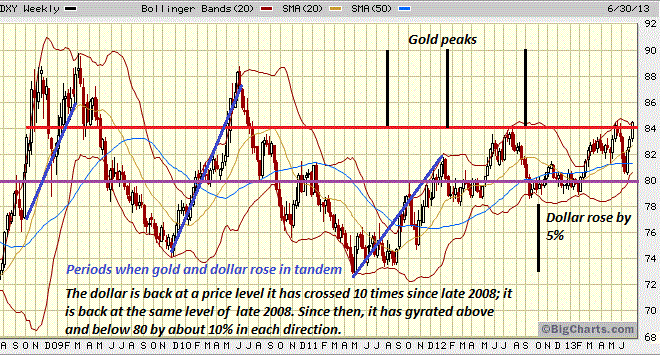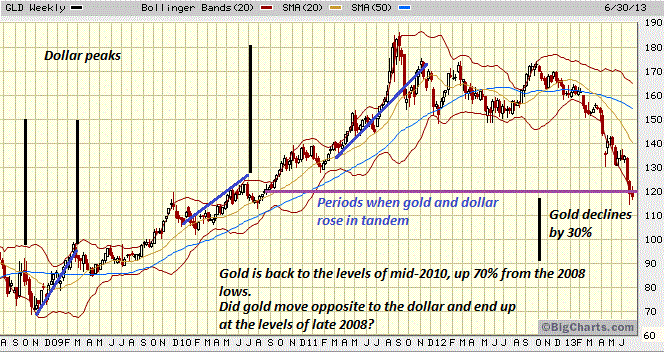The supposed correlation of the U.S. dollar and gold is not visible in the 5-year charts.
One of the most widely accepted truisms in what passes for our financial media is that the dollar and gold are correlated: when the dollar weakens, gold rises, and when gold rises, the dollar declines.
Nice, except this vaunted correlation isn't remotely visible in the charts. Let's have a look. Here is the 5-year chart of the DXY Dollar Index, the most widely quoted measure of the U.S. Dollar:
And here is a 5-year chart of GLD, a proxy for gold:
I've marked the charts up seeking the sort of correlation that is accepted with near-religious faith and come up with near-random fluctuations. Let's start with the basics of correlation:
1. Do the peaks and troughs align? No, they don't. If gold and the DXY were correlated, we'd expect gold to bottom when the dollar peaked and the dollar to hit its lows at gold's peak. Instead, we find gold was rising when the dollar hit its last peak in mid-2010.
At gold's peak, the DXY was around its previous lows hit in 2008 and 2009. At the dollar's previous low in 2008 at 72, GLD was around 100; at the dollar's next low in late 2009 at 74, GLD was around 110. At the low in 2010 at 73, GLD was 150.
Conclusion: the peaks and troughs do not align--not even close.
2. Do the trends up and down align inversely? In other words, when gold is rising, is the dollar declining, and vice versa? Nope. The supposedly inversely correlated DXY and GLD have risen in tandem for several significant stretches of time.
We can play mind-games and claim the correlation inverted during these periods, but what would we base this claim on? Why did the correlation invert during these periods?
3. Were major uplegs/downlegs matched by similar percentage moves in the other index?If there was any sort of real correlation, we would expect to see a 30% rise or fall in one align with a similar-sized inverse move in the other.
For example, gold dropped by 30% since October 2012, yet the DXY rose a mere 5% in that period, crossing a price line it has crossed 9 times before.
When the DXY rocketed up 20% from late 2009 to mid-2010, we'd expect gold to plummet by 20% in the same timeframe. Instead, gold rose in tandem with the dollar.
4. If one has climbed by 70% since late 2008, the other should decline by roughly 70%.Instead, the dollar is back where it was in late 2008 at 84, a price level it has crossed 10 times since late 2008.
Gold has risen 70% from its late-2008 level. How are these dramatically different price movements correlated?
Conclusion: there is no correlation between gold and the U.S. dollar index. Not even close.The two move independently; any apparent correlation is semi-random signal noise. They are not on a simplistic see-saw.
In my view, this reflects the complex dynamics at work in pricing gold and the U.S. dollar:
Things are falling apart--that is obvious. But why are they falling apart? The reasons are complex and global. Our economy and society have structural problems that cannot be solved by adding debt to debt. We are becoming poorer, not just from financial over-reach, but from fundamental forces that are not easy to identify or understand. We will cover the five core reasons why things are falling apart:
 1. Debt and financialization
1. Debt and financialization
2. Crony capitalism and the elimination of accountability
3. Diminishing returns
4. Centralization
5. Technological, financial and demographic changes in our economyComplex systems weakened by diminishing returns collapse under their own weight and are replaced by systems that are simpler, faster and affordable. If we cling to the old ways, our system will disintegrate. If we want sustainable prosperity rather than collapse, we must embrace a new model that is Decentralized, Adaptive, Transparent and Accountable (DATA).
We are not powerless. Not accepting responsibility and being powerless are two sides of the same coin: once we accept responsibility, we become powerful.
Kindle edition: $9.95 print edition: $24 on Amazon.com
To receive a 20% discount on the print edition: $19.20 (retail $24), follow the link, open a Createspace account and enter discount code SJRGPLAB. (This is the only way I can offer a discount.)
| Thank you, Jeff N. ($100), for your outrageously generous contribution to this site -- I am greatly honored by your support and readership. | | Thank you, Michael H. ($5/month), for your stupendously generous re-subscription to this site -- I am greatly honored by your steadfast support and readership. |


 1. Debt and financialization
1. Debt and financialization


























